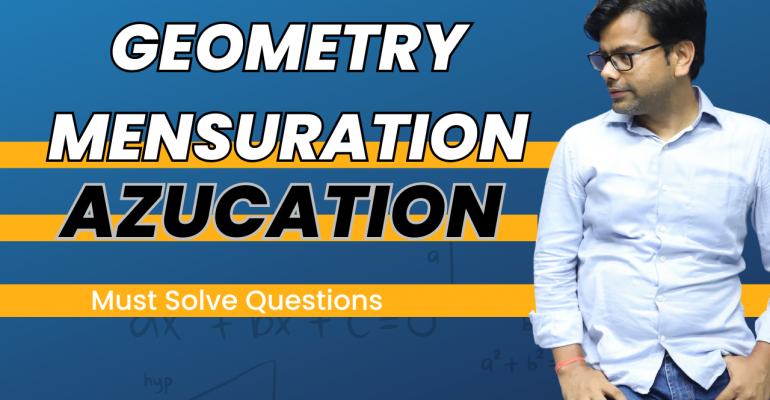Geometry Questions : Parallel Lines and Angles – Must Practice Set for CAT, XAT & Other MBA Exams
May 27, 2024 2025-05-29 21:11Geometry Questions : Parallel Lines and Angles – Must Practice Set for CAT, XAT & Other MBA Exams

Geometry Questions : Parallel Lines and Angles – Must Practice Set for CAT, XAT & Other MBA Exams
Geometry Concepts: Parallel Lines and Angle Formations
This blog explains two fundamental yet powerful concepts related to angles formed by parallel and transversal lines. These are frequently tested in aptitude exams like CAT, XAT, and SSC CGL.
1) Angles Formed by Two Sets of Parallel Lines
In the figure below, we observe two sets of parallel lines intersecting each other, creating multiple angle junctions. The small angle formed at each intersection is given as $50^\circ$. We are to find the total of $x + y + z$.
 🔽 Show Explanation
🔽 Show Explanation
Explanation:
We are given the small interior angle is $50^\circ$ at all intersections. At each intersection, the lines form vertically opposite and corresponding angles.
From the diagram:
\[ x = 130^\circ,\quad y = 50^\circ,\quad z = 130^\circ \] \[ x + y + z = 130^\circ + 50^\circ + 130^\circ = 310^\circ \]

2) Different Types of Angle Configurations
The image below depicts different scenarios where angles are formed at intersections of lines. These include interior, exterior, linear pair, and arrow-like shapes.
 🔽 Show Explanation
🔽 Show Explanation
Explanation:
- Case 1: The total angle around a point is $360^\circ$. So, the unknown angle = $360 - (x + y)$.
- Case 2: In a polygon-type intersection, the interior angle is calculated as $360 - (x + y)$.
- Case 3: Linear pair angles are supplementary: $x + y = 180^\circ$, so exterior angle = $x + y - 180^\circ$.
- Case 4: Arrow shape angles have a directional difference: $y - x$.
These configurations are especially useful in questions involving polygon traversal, road/track diagrams, and path-based reasoning.
📐 Geometry Parallel Lines and Angles Practice Questions- MCQs – CAT & XAT Level Practice
Compiled by Maths By Amiya. Click below to reveal answers and video walkthroughs.
1) If A∥B∥C and l∥m∥n, then \(x + y + z = ?\)


- (a) 300
- (b) 350
- (c) 210
- (d) None
Answer: (d) None (Actual: 450)
2) If A∥B∥C and l∥m∥n, then \(x + y = ?\)


- (a) 100
- (b) 140
- (c) 250
- (d) None
Answer: (c) 250
3) If A∥B and NM and NL are angle bisectors of angle M and L respectively, then \(x = ?\)


- (a) 50
- (b) 60
- (c) 40
- (d) None
Answer: (a) 50
4) If A∥B, then \(x = ?\)


- (a) 10
- (b) 20
- (c) 30
- (d) None
Answer: (b) 20
5) If A∥B, then \(x = ?\)


- (a) 70
- (b) 110
- (c) 80
- (d) None
Answer: (c) 80
6) If A∥B∥C, then \(x - y = ?\)


- (a) 20
- (b) 10
- (c) 0
- (d) None
Answer: (c) 0
7) If AB∥CD∥EF, then \(y + z - x = ?\)


- (a) 200
- (b) 100
- (c) 300
- (d) Cannot be determined
Answer: (a) 200























Search
Featured Courses








